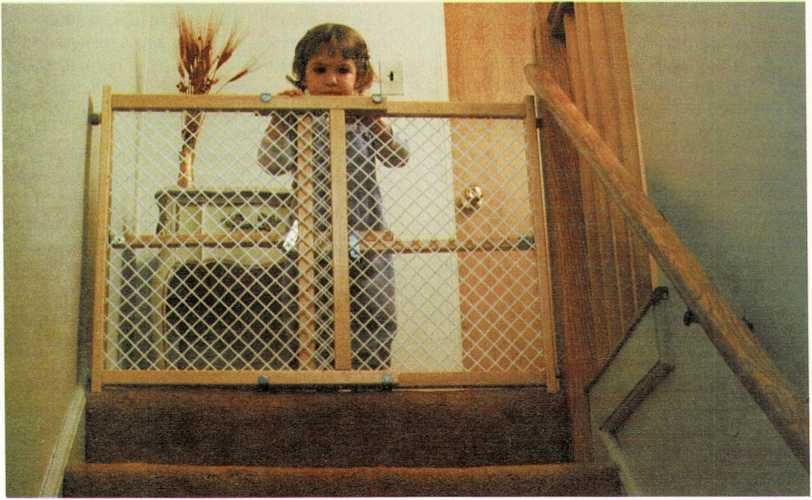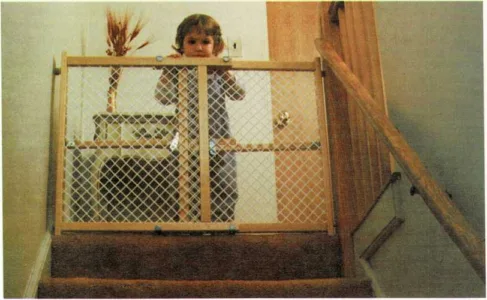Health and safety
Accidents
One function of parents is to prevent their children from hurting
themselves in a dangerous world. A toddler’s all-embracing habit of
getting into everything needs its rightful outlets, but it also calls
for strong checks and a defining of limits. Toddlers are surrounded by
many dangers, and so they must necessarily be surrounded by many
safeguards.
Toddlers need to be both hemmed in and kept out. Closed doors are not
enough, because toddlers soon learn to turn knobs. Locked doors keep
toddlers out of poten
tially dangerous places. Safety gates also provide restraints in
dangerous places, such as the top or bottom of stairs.
Bathrooms especially need to be safe. The contents of medicine cabinets
fascinate toddlers. The shapes and colors of bottles draw children to
this cabinet. As toddlers become adept at unscrewing or removing bottle
tops, they are more likely to sample the contents.
To protect your child, buy medicines and drugs with child-resistant
caps. Even so, keep medicines locked up. Be sure to return them to the
cabinet after use. If the pretty

Gates at the top and bottom of stairs can prevent many toddler
accidents.These safeguards may make your toddler unhappy, but they are
necessary.
pills are out of sight, your toddler will not be tempted to taste or eat
them. The major cause of child poisonings is aspirin and aspirin
substitutes, so buy them in small amounts and keep them in a safe place.
Added hazards arise as toddlers learn to climb. They don’t confine
themselves to the usual climbing, like stairs. They are all too often
after things that are out of reach. They quickly learn where the cookies
are kept, and they will most likely have a special interest in climbing
on top of radiators or furniture to get to window ledges.
Toddlers also have a great desire to poke and pry, which often leads to
probing electric outlets with hairpins or bobby pins. You can buy covers
for your electric outlets from a hardware store.
To further accident-proof your home, kneel down on the floor and pretend
you are a toddler bent on exploring everything within reach. Is the cord
for the coffeemaker still plugged into the wall? Is a purse with pills
in it within reach? Does the coffee table have sharp edges? Are ant
paste, paints, cleansers, and soaps within reach? Look at your stove.
Have you left any pot handles pointing into the room? Be sure to have
one or more smoke detectors in your home, and check them once a month to
be sure they are working properly.
Teach your toddler to buckle up immediately on getting into a car. Don’t
start the car until everyone is buckled up in a seat belt.
Common conditions and infectious diseases
A healthy toddler frequently develops minor infections. A parent can
expect a child in this age gi\’oup to have 5 to 6 colds per year, 2
episodes of gastroenteritis (diarrhea), and 1 to 2 episodes of otitis
media (ear infections). Day care is a minor risk factor which will
increase these frequencies. Older children who have been in day care
seem to have fewer common illnesses later because their resistance has
been built up. One or more smokers in the household greatly increases
the number of cold-like illnesses a child will have. Fever may also be
common at this time. It may be the first sign of a
serious infection. For a temperature of over 101° F. (38.2° C), consult
your pediatrician. In most cases, toddlers are resilient and bounce back
quickly to normal activity once illness peaks.
The frequency of previously common contagious diseases such as measles,
German measles, diphtheria, whooping cough, mumps, and polio has been
drastically reduced because of current immunization procedures. Chicken
pox remains a common contagious disease that toddlers easily catch if
exposed to it. If children are healthy, they may be miserable with the
disease for a few days, but in most cases complications do not occur. In
this age group aspirin is not advised for the treatment of fever because
of its association with Reye’s syndrome. It is particularly important
that children with chicken pox not be given aspirin.
Noninfectious conditions also are common during this age period. A
number of these result from confusion regarding diet. Parents often
become concerned because their toddlers are “picky eaters” or have “poor
appetites.” Usually if toddlers are offered a variety of foods and
balanced diets, even the picky eaters will balance their diets over
time. Parents should be assured that if the children’s height, weight,
and physical exams are normal and if the age-appropriate screening tests
(see below) are normal, their children’s diets are probably
satisfactory. Making mealtime or food an issue can lead to future
problems.
Constipation is common among toddlers because parents often urge them to
consume too much milk and other dairy products. Consequently, the
children do not eat enough meat, fruit, and vegetables, which have more
fiber than milk and bread.
Anemia, because of iron deficiency, is common for the same reason as
constipation. Parents encourage toddlers to eat large quantities of
dairy products at the expense of other foods, such as meat and green
vegetables. Iron deficiency results because white foods contain
relatively little iron.
A final condition that can be a problem for toddlers is lead poisoning.
It usually occurs in areas polluted with lead (air, water, and so on)
and in areas where houses have lead- base paint. Children may have high
levels of
lead without symptoms, but high levels of lead can lead to serious,
acute illness or long-term effects. Parents concerned about childhood
lead poisoning should consult the pediatrician.
Preventive Health Care
Two or three visits to the pediatrician for preventive health care are
recommended for the child between the ages of 18 and 36 months. At the
beginning of the visit, the pediatrician observes the child and
discusses any concerns the parents might have. The doctor will also ask
about the child’s behavior, development, and diet. A thorough physical
examination follows. With information obtained from these procedures,
the pediatrician will counsel the parents regarding any condition
identified, expectations for the child’s behavior, and the child’s
expected development in the near future. Pertinent safety issues will
also be discussed. At the conclusion of the visit, age-appropriate
preventive measures are ordered by the pediatrician. These measures
usually include immunizations and screening tests.
When the child reaches 18 months, most physicians will give the child
the DPT shot—diphtheria, pertussis (whooping cough), and tetanus
(lockjaw)—and the OPV (oral polio vaccine). These are boosters for the
primary series of immunizations given to the child in infancy. At this
same age, it is also recommended that the toddler also receive the HIB
shot (H influenza B). This vaccine is effective in preventing H
influenza B, meningitis, and epiglottitis (bacterial croup).
During the office visit, the pediatrician may also take blood samples
from the toddler for screening tests for iron deficiency anemia and lead
poisoning. Screening tests are a major cornerstone of preventive care.
These tests are performed at ages when children are prone to a disease
or a condition, but before the child has symptoms. Identifying such
conditions early and beginning treatment can prevent more serious
illnesses.
Finally, by 18 months, the child will be screened for tuberculosis. If
an exposure has occurred since the screening, the physician will test
the child again for tuberculosis.
For more information, see the following articles in the Medical Guide:
[Chicken pox, Diphtheria, Immunization, Tetanus,
Tuberculosis,] and [Whooping cough.]{.smallcaps}
Teeth, feet, eyes, and ears
“Toothbrush at 2, the dentist at 3” is a rule that encourages good
dental habits. When toddlers near 2, they probably watch with
fascination while their parents brush their teeth. Because of their
passion to imitate things other people do, they will probably want to
brush their teeth, too. This is a great time to hand toddlers their own
toothbrushes and let them try. They will not brush well at first, but
with a little help they will catch on. The best time to have toddlers
brush is after each meal. This means three times a day, which in most
homes is nearly impossible. The most important brushing time is after
supper. This brushing cleans teeth for the long night ahead. If brushing
three times a day fails, aim for two times—after breakfast and after
supper.
A fluoride is a compound that helps make teeth strong and reduces tooth
decay. In many areas children receive fluoride from the water they
drink. If fluoride is not available in the water, they should receive it
as a supplement prescribed by their doctor or dentist.
If your toddler walks with the toes of both feet pointing inward and the
heels pointing outward, the child is pigeon-toed. This condition is
common before walking is well established. Corrective measures are taken
only under extreme circumstances.
The lazy eye begins in this age group. The muscles of the lazy eye are
weak and, if they are untreated, they may cause the eye to cross.
Usually, a doctor puts a patch over the child’s good eye so that the
lazy eye has to work harder.
If your child has not imitated any words by the age of 2, he or she may
have a hearing loss. Consult your pediatrician. The doctor will probably
suggest that you take the child to a specialist in hearing problems, so
that the child’s hearing can be evaluated. For more information, see
[Deafness] in the Medical Guide.

